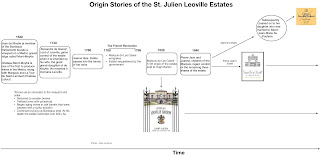The three current Léoville estates had a common beginning back in 1638 when Jean de Moytie founded a vineyard on a Medoc gravel ridge and named it Mont Moytie. This estate, along with Margaux and Latour, was the earliest wine producer in the region and remained a unit until the period 1826 to 1844 when it was split into three separate entities. The chart below details the history of the estate up until its dismemberment.
A cellar did not come with the Léoville purchase so the decision was taken to vinify the grapes at Langoa Barton, a Barton property proximate to the purchased vines. That practice is still in place today with the chateau displayed on the Leoville Barton label actually being the Langoa Barton chateau. The family has now owned and controlled these vineyards and wines for well nigh 200 years.
Anthony Barton, who succeeded Ronald Barton, became a crusader for fair pricing to the consumer, a position which has "earned the brand a strong and loyal fanbase."
Léoville Barton is a St. Julien estate. Saint Julien, being south of Pauillac, is slightly warmer but still subject to similar climate-modification effects (see chart below). The soil is similarly gravelly but has less clay and limestone.
The vineyard rests on 51 ha of deep gravel on clay soils supporting the Cabernet Sauvignon (74%), Merlot (23%), and Cabernet Franc (3%) vines. Average vine age is 38 years and planting density is 9000 vines/ha. The vineyard is mostly organic.
As regards winemaking, the hand-harvested grapes are destemmed, sorted, and crushed prior to being gravity-fed into 200-hl wooden vats for fermentation. The must is co-inoculated to allow almost-simultaneous alcoholic and malolactic fermentation. The fermented wine is aged in 60% new French oak for 20 months, with barrel top-ups three times per week. Racking is done using the l'esquive method.
According to thewinecellarinsider.com, "Léoville Barton is a sturdy, structured Bordeaux wine with tannin that requires time to develop. Traditional, masculine and beefy in style, this property is popular with some collectors because of the reasonable prices the estate charged for their wines. Due to the high tannin levels and style of the wine, the best vintages often require decades of age before drinking well."
Tasting selected vintages of Léoville Barton
The Orlando Tasting Group convened on June 7th to taste selected vintages of this estate's wines. The table below indicates the vintages tasted and, where available, the varietal composition. The table reveals the wine as primarily a Cab-Merlot blend with limited Cabernet Franc contribution. The wines were flighted by decade, youngest to oldest.
Year | Cabernet Sauvignon (%) | Merlot (%) | Cabernet Franc (%) |
2005 | 73.5 | 26 | 0.5 |
2004 | 75 | 23 | 2 |
2003 | 69 | 27 | 4 |
2000 | 74 | 24 | 2 |
1998 | 72 | 20 | 8 |
1996 | 72 | 20 | 8 |
1995 | 78 | 19 | 3 |
1993 | |||
1990 | 70 | 25 | 5 |
1982 | 72 | 20 | 8 |
1976 | |||
1975 |
2005 Chateau Léoville Barton
Beautiful nose of coal, tar, cassis, and chocolate. Broad on the palate with coal tar, blackpepper, and minerality. High acidity. Still not open; needs more time.
2004 Chateau Léoville Barton
Dark red fruit, baking spices, licorice, leather, tobacco, and bay leaf on the nose. Red and dark cherries on the palate. Silky, with a lengthy finish.
2003 Chateau Léoville Barton
Dark fruit, cigar box, cremé de cassis, and graphite on the nose. Expressive on the palate. Medium-bodied. Sweet currants, plum and minerality. Elegant and balanced. This was eventually adjudged the wine of the flight.
2000 Chateau Léoville Barton
Aromatic. Pauillac nose along with baking spices and a savory character. Persistent, thick, rich, and concentrated on the palate. Long, drying finish.
Flight 2: The 1990s
1998 Chateau Léoville Barton
Conditions were very good for this vintage with early bud break and flowering with a hot, dry August favoring good ripening. This particular bottle had issues. Granny's attic and acetic acid on the nose. Dead on the palate.
1996 Chateau Léoville Barton
Mature Bordeaux on the nose with graphite, blue fruit, cassis and leather. Nose carries through to the palate. Silky tannins.
1995 Chateau Léoville Barton
Dark fruit along with sage, earth, cedar, and leather on the nose. Smooth tannins and a lengthy finish. Wine of the flight.
1993 Chateau Léoville Barton
Berries, cassis, graphite, cigar box, cedar on the nose. Medium-bodied. Smooth and balanced with a long finish.
1990 Chateau Léoville Barton
Uninspiring nose but great on the palate. Rich and savory with spicy dark fruit. Excellent finish. Delicious.
Flight 3: The 1980s
1982 Chateau Léoville Barton
Red/black fruit, tobacco, leather, graphite on the nose. Sweet black fruit, leather and iron on the palate. Great length on the finish. A great year overall for Bordeaux and this estate did not miss the boat. Obviously wine of the flight but also picked as wine of the night.
Flight 4: The 1970s
1976 Chateau Léoville Barton
Forest floor, leather, tea, coffee, and tobacco on the nose. Earth and tea on the palate. Age is showing. Adjudged wine of the flight.
1975 Chateau Léoville Barton
Red fruit, cedar, cassis, leather, and earth on the nose. Red fruit and spice on the palate. Textured. Long finish.
Next up in our tasting series is Chateau Leoville Poyferre.














